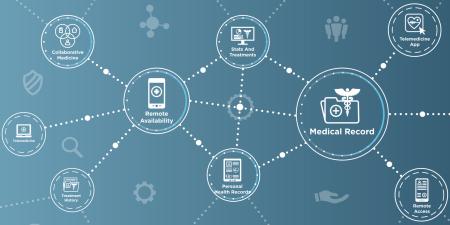Telemedicine—broadly defined as using telecommunications technologies to transmit medical information to support clinical care—has increasingly captured the attention of patients, physicians, insurers, and politicians over the last several years as its breadth and impact have expanded. Telemedicine’s movement from the fringe toward the mainstream of clinical practice has generated new models for efficient patient care and decreased disparities in access to care—and drawn attention to its limitations and shortcomings.
Each new technology and technique in medicine—from the invention of the stethoscope to the application of genetics—forces us to ask about the value of “the old way” and to question whether “the new way” comes at too high a cost. With the stethoscope, doctors began to listen to the patient’s heart and lungs, sometimes at the cost of listening to the patient [1]. In The Worth of a Child [2], Thomas Murray asks: Should our understanding of genetics give us the go ahead to alter or “select out” genetic material to produce a child who suits our wishes. So it is with telemedicine. Does telemedicine provide a specialist for a patient who would otherwise not see one, or does it threaten the therapeutic power of the hands-on patient-physician relationship? Its transformative possibilities are readily apparent, but the gathering of rigorous evidence to support its use and quell concerns is still in progress.
In this issue of Virtual Mentor, we are pleased to highlight insights and perspectives from authors with intimate knowledge of the telemedicine landscape. Our three ethics cases, drawn from real-life scenarios, raise important questions regarding the impact of telemedicine in a range of clinical settings—the outpatient clinic, the emergency room, the intensive care unit—and medical specialties—psychiatry, radiology, and critical care.
The first ethics case commentary, written by Richard Gunderman, MD, PhD, provides insights into both the benefits and challenges of teleradiology and how communication between physicians is critical in an era of decentralized practice. In their case commentary, Nicholas Freudenberg, MD, and Peter M. Yellowlees, MBBS, MD, identify the need for comprehensive mental health care and examine how physicians can maintain the appropriate standard of care when practicing telemedicine. In the third ethics case commentary, Allison Harriot, MD, MPH and Michael A. DeVita, MD, respond to a case about a tele-intensivist managing a critically ill patient from afar. The breadth of these cases demonstrates the pervasiveness of telemedicine in today’s medical care environment and invites physician readers to consider the ethical implications of the integration of telemedicine technologies into their own practice.
As telemedicine becomes more and more common, we must begin to train the next generation of physicians in telehealth modalities. In this month’s medical education article, Neal Sikka, MD, Tina Choudhri, MD, and Robert Jarrin, JD, discuss the current and needed integration of telemedicine into medical education curricula. They describe and discuss the telemedicine and digital health fellowship they have established at George Washington University, one of the nation’s first, to train future leaders in telemedicine.
The rapid expansion of telemedicine has outpaced policy making in the areas of guidelines, standards, licensing, and payment for services. Karen Rheuban, MD, Christine Shanahan, and Katherine Wilson assess the current local and national policies regarding payment and clinical practice guidelines and standards for telemedicine and argue that greater coordination among stakeholders is needed. Mei Wa Kwong, JD, Mario Gutierrez, MPH, and James P. Marcin, MD, MPH, discuss the need for interstate licensing for physicians practicing telemedicine and highlight pending state and federal legislative action on the issue.
The ability of telemedicine to provide physicians with a means of transcending geographic limitations in a clinical encounter offers the possibility of greatly expanding access to medical services. One institution that has decades of experience with such delivery models is the Indian Health Service (IHS). Howard Hays, MD, MSPH, Mark Carroll, MD, Stewart Ferguson, PhD, Christopher Fore, PhD, and Mark Horton, OD, MD, give an overview of the IHS’s uses of telemedicine—particularly in behavioral health and ophthalmology—and the clinical impact it has had. Eseosa Asemota, MD, MPH, and Carrie L. Kovarik, MD, describe the role of virtual patient care in humanitarian efforts around the globe, underscoring both the opportunities and challenges associated with this practice.
Telecare undoubtedly has the potential to change the patient-physician relationship. Shivan J. Mehta, MD, MBA, cautions that we must avoid ethical pitfalls such as inadequate personalization and blind embracing of novelty in working with telemedicine tools. Timothy M. Hale, PhD, and Joseph C. Kvedar, MD, discuss a recent paper that examined the privacy and security risks of telemedicine and recommend addressing these concerns through a comprehensive set of privacy and security standards and regulations.
The innovations and challenges examined in this issue have already begun to transform the conception of a “doctor visit.” We still have much to learn about what these changes imply for the practice of medicine, the ethics of clinical care, and the prevention and elimination of disease. We invite you to read through this month’s Virtual Mentor to explore some of these very questions.
References
- Baron RJ. An introduction to medical phenomenology: I can’t hear you while I’m listening. Ann Intern Med. 1985;103(4):606-611.
-
Murray TH. The Worth of a Child. Berkeley, CA: University of California Press; 1996.



